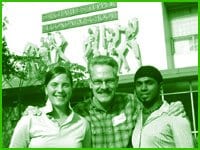“My school is awful,” sighs Roz Kromhoff, a bisexual Grade 11 student at Langley’s school of fine arts.
It’s full of homophobic slurs, but the teachers don’t do anything about it, she explains. “I’m just, like, ill seeing what happens there.”
Kromhoff is one of 175 students, teachers, teachers-in-training and support staff who poured into Sir Charles Tupper secondary school in East Vancouver Oct 24 for the second annual Get Engaged conference on building queer-friendly schools.
Participants spent the day swapping stories, forging support networks, fighting homophobia and trying to create safer schools.
The community has to take the lead on these issues because the government seems reluctant to do it, says Joan Merrifield, who presented a practical workshop on how to counter the homophobic name-calling that pervades most BC schools.
(Start by directly addressing the name-calling, she advises. Label it homophobia, tell the perpetrators to stop, and record the incident. Then tackle the underlying myths and stereotypes fuelling the homophobia. Incorporate positive images of famous gays and lesbians into the curriculum, for example. And change the code of conduct to make the school a safe-language zone, she suggests.)
Merrifield should know. She teaches Grade 6 in Nanaimo and is a member of Gay and Lesbian Educators of BC (GALE-BC). GALE helped organize this year’s Get Engaged conference, in conjunction with Gab youth services at The Centre and a local youth organization called Kinex.
Change only happens when people stand up and demand it, Merrifield says.
Olivia Higgins agrees. Higgins, who came to town specifically for the conference, provides support services for queer youth in the San Francisco school system. She says her job owes its existence to a community uproar in the late 1980s demanding more support for queer students.
Earlier this year, the BC government’s Safe Schools Task Force disappointed many queer activists when it released its recommendations. Not one of them directly addressed homophobia.
Now, Education Minister Christy Clark is expected to release her own school guidelines, based on the task force’s recommendations, any day. Though she could go beyond the recommendations, insiders say an early draft of her guidelines contains no specific references to homophobia, either.
The government’s reluctance to tackle homophobia in schools “sucks,” Kromhoff says. It looks like students are going to have to make the changes they need themselves, she adds.
For starters, she’d like to see more teachers take a stand against the homophobia around them. Grade 12 drama students in her school regularly present homophobic skits while the teacher looks silently on, she says.
“I’d like to see teachers saying: ‘No, that’s not cool. I won’t have that in my classroom.'”
But it’s not just the teachers, Kromhoff continues. Students have to start supporting each other, too, she says, stressing gay-straight alliances.
Conference organizers were thrilled with the response they received this year, especially from the youth, who accounted for an estimated two-thirds of the attendees. Now they’re hoping to harness that energy and “push it forward,” says Teya Greenberg from Kinex.
Change will come from the students, she agrees-and the momentum is growing. She and Romi Chandra of Gab youth services have scheduled a follow-up meeting for the youth on Nov 6, from 4-6 pm at The Centre.

 Why you can trust Xtra
Why you can trust Xtra


